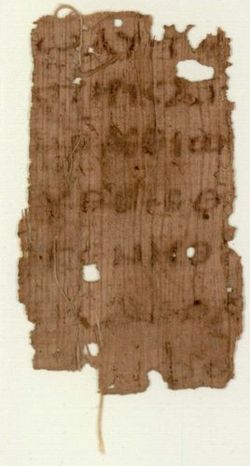|
Matthew 28
Matthew 28 is the twenty-eighth and final chapter of the Gospel of Matthew in the New Testament. This chapter records that Jesus is risen, describes the actions of the first witnesses to this event, and ends with the Great Commission. TextThe original text was written in Koine Greek. This chapter is divided into 20 verses. Textual witnessesSome early manuscripts containing the text of this chapter are:
King James Version1 In the end of the sabbath, as it began to dawn toward the first day of the week, came Mary Magdalene and the other Mary to see the sepulchre. OverviewThe first section,[4] verses 1-10, covers the visit of Mary Magdalene and "the other Mary" (Mary, the mother of James and Joses in Matthew 27:56) to the tomb of Jesus. The greek "εις μιαν σαββατων" literally reads "toward [the] first [day] of the sabbath", but is usually translated "first of the week."[5] There an angel descends, opening the tomb and incapacitating the guards. The angel addresses the women, inviting them to see the place where he ("the Lord") had been laid, and to tell Jesus' disciples that he is (or has) risen.[6] As they leave the area, they encounter the risen Jesus. In the second section,[4] verses 11-15, the guards return to Jerusalem, where they report to the chief priests about the events and the priests bribe the guards to lie about what has happened and tell that the disciples had come and stolen the body. In the third section,[4] verses 16-20, Jesus appears to the disciples in Galilee and issues the Great Commission ending with a trinitarian formula which is much disputed by modern scholars.[7][8] Henry Alford notes that the Ascension of Jesus is not recorded in Matthew's Gospel, but suggests that it is implied in the words "I am with you always", in the final verse.[9] The Textus Receptus Greek text and the King James Version end verse 20 with the Greek: Ἀμήν, Amen, but the majority of ancient texts and modern English translations do not include this word.[10] The Pulpit Commentary suggests that "the word is here an interpolation".[11] SourcesTradition sites of Jesus' tomb Matthew 28 covers the same material as Mark 16, Luke 24, and John 20 in the other gospels. As with the rest of Matthew it seems clear that Matthew is adapting what appears in Mark. Unusually the material not from Mark most closely matches the Gospel of John, unlike the rest of the gospel where non-Markan material is often matched in Luke. Some scholars thus believe that the authors of Matthew and John may have been working from a shared source on the resurrection that wasn't used by the other two gospel writers. A variation on the appearance of Jesus to the women does occur in John, but the wording is completely different in Matthew. The meeting with Jesus is a close variation on the meeting on the women's meeting with the angel, and may be based on that text originally from Mark.[12] The report of the guards is wholly unique to Matthew, but is matched with the guards content in Matthew 27. This material is thus a creation of Matthew's author, or based on a source only used by that writer. It also parallels the story of the women and the resurrection. This section is clearly apologetical, meant to address anti-Christian allegations that were current at the time of its writing.[13] The final meeting of Jesus and the disciples to issue the Great Commission appears in all four gospels, but with much variation. In Luke the meeting occurs in Jerusalem and it is also indicated that is the location in John. Mark does not give a location, but in Matthew it happens in Galilee. While similar to Mark, it is not believed that this section is based on that gospel, as the current ending of Mark 16 is today believed to be a later addition. Some scholars believe that the author of Matthew may have been working from the lost ending of Mark.[14] ReceptionSome early Christian writings appealed to Matthew 28:19. The Didache (7.1), written at the turn of the 1st century, borrows the baptismal Trinitarian formula found in Matthew 28:19. The seventh chapter of the Didache reads "Having first said all these things, baptize into the name of the Father, and of the Son, and of the Holy Spirit". In addition, Tertullian, writing around the turn of the 2nd century (~200 CE), also cites the baptismal Trinitarian formula from this Matthean passage twice in his writings. In the 26th chapter of his Against Praxeas, arguing against a Unitarian understanding of God, Tertullian cites this formula, writing "He commands them to baptize into the Father and the Son and the Holy Ghost, not into a unipersonal God." In addition, in the 13th chapter of Tertullian's On Baptism, he cites the formula in order to establish the necessity of the practice of baptism, writing "For the law of baptizing has been imposed, and the formula prescribed: "'Go,' He says, 'teach the nations, baptizing them into the name of the Father, and of the Son, and of the Holy Spirit.'" VersesSee also
References
External linksWikimedia Commons has media related to Gospel of Matthew - Chapter 28.
|
||||||||||||||
Portal di Ensiklopedia Dunia


